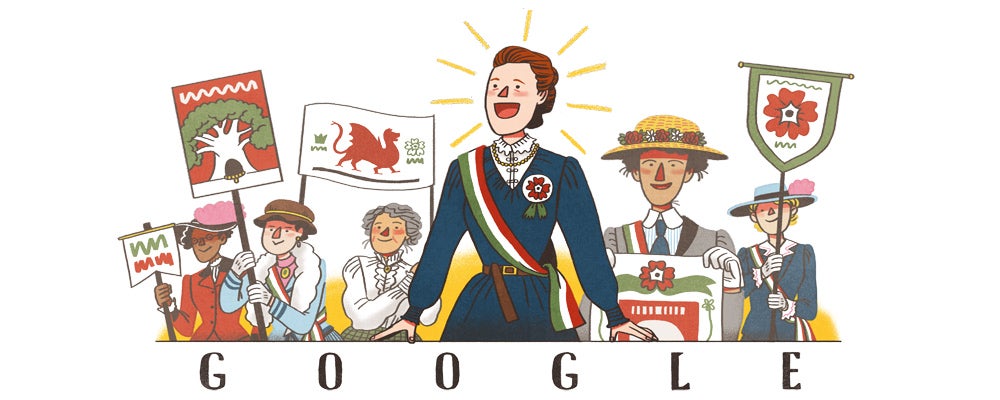Millicent Fawcett: Who was the tireless suffragist and how did she change women's voting rights forever?
Google marks the 171st anniversary of the activist's birthday with a Doodle
Google has celebrated the 171st anniversary of suffragist Millicent Fawcett’s birthday with a Doodle.
Dame Millicent was a leading light of the woman’s suffrage movement and formed the National Union of Women’s Suffrage Societies in 1897. It was the largest association of its kind and a precursor to the more famous and radical Suffragette movement led by the Pankhurst family.
The organisation, which Dame Millicent was president of until 1919, distanced itself from the militant activities of the suffragettes and pursued a campaign of non-violence to achieve their goals.
Its tactics included peaceful demonstration and the lobbying of MPs and it stressed its membership consisted only of “law-abiding suffragists” – at loggerheads with the more militant tactics of the Pankhursts’ Women’s Social and Political Union (WSPU).
The colours of her suffragist movement were green, white and red which stood for Give Women Rights – and the Doodle has represented them accordingly.
The doodle shows Ms Fawcett campaigning alongside other suffragettes. Images released by Google of early concepts of the Doodle show Dame Millicent speaking to a group of women, and giving her famous quote: “Courage calls for courage everywhere.”
Dame Millicent, who was famed for her clear but expressive speaking voice and razor-sharp intellect, was recently honoured with the unveiling of a new statue in Parliament Square in London.
The monument, created by Turner Prize-winning artist Gillian Wearing, was the first of a woman to be unveiled in the square and marked a century since MPs passed the Representation of the People Act which bestowed some women with the right to vote for the first time.

Born in Aldeburgh, Suffolk, on 11 June 1847, Dame Millicent was the eighth of 10 children in a family of prosperous barley merchants.
“The Garretts were a close and happy family in which children were encouraged to be physically active, read widely, speak their minds, and share in the political interests of their father, a convert from conservatism to Gladstonian liberalism, a combative man, and a keen patriot,” according to Ray and Barbara Strachey’s book The Cause: A Short History of the Women’s Movement in Great Britain.
Her older sister Elizabeth Garrett Anderson – who went on to become Britain’s first female doctor – introduced her to Emily Davies as a child. Davies was a fellow suffragist and trailblazing campaigner for women’s rights to university access.
At the age of 12, Dame Millicent was sent away to boarding school in Blackheath, London, with her sister Elizabeth.
This was a formative time for Dame Millicent. At the age of 19, she heard a speech by the radical MP John Stuart Mill – an early supporter of universal women’s suffrage – that inspired her to become involved in politics and seek fair representation for all.
Awestruck by Mill’s radical credentials, she became actively involved in his campaign, becoming secretary of the London Society for Women’s Suffrage at the age of just 19.
Mill went on to introduce her to many other women’s rights activists – including Liberal MP Henry Fawcett who initially planned to marry her sister Elizabeth before she chose to focus on her medical career.
In spite of their 14 year age gap, Dame Millicent and Henry married in 1867. The couple had a daughter called Philippa.
It was not until 1868 that Dame Millicent joined the London Suffrage Committee and spoke at the first public pro-suffrage meeting to be held in London.
The tireless campaigner, who considered herself a moderate, was also a leader in education, helping to found the all-women Newnham College at Cambridge University.
Her lengthy and illustrious career also saw her lobby for the criminalising of incest and of cruelty against children within the family and for the repeal of the Contagious Diseases Act, which punished prostitutes for passing venereal complaints on to their clients. In 1901, she investigated Britain’s use of concentration camps in South Africa during the Boer War.
She did this all alongside being a mother and caring for her husband who was blinded in a shooting accident in 1858.
She was made a dame in 1925 and died at her home in Gower Street, London in 1929 – a year after women were granted full equality in voting without a property requirement.
Join our commenting forum
Join thought-provoking conversations, follow other Independent readers and see their replies
Comments